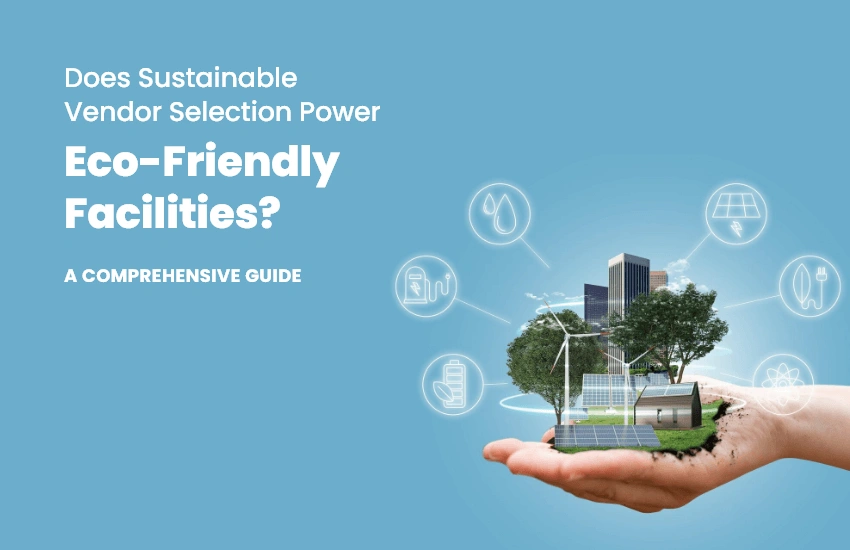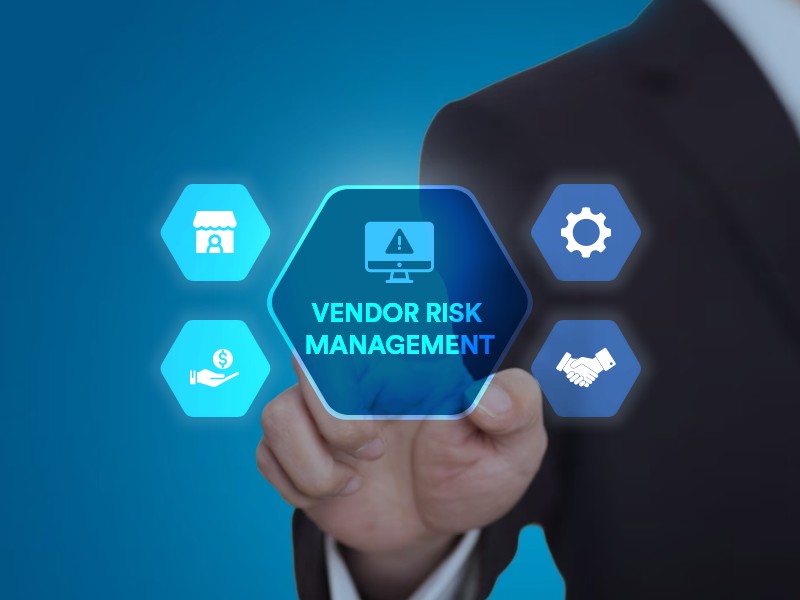Does Sustainable Vendor Selection Power Eco-Friendly Facilities? A Comprehensive Guide

As our society becomes increasingly aware of our environmental challenges, sustainability has emerged as a beacon of hope. We all imagine a world where every choice, no matter how small, has the potential to make a substantial difference. But how do we transform this hope into tangible action? This is also the inspiration behind our topic of discussion: Can a sustainable vendor help build an eco-friendly facility? The answer is Yes!
As more people become environmentally conscious, businesses will adopt sustainable practices. it’s imperative to recognize that we inhabit a single planet, a shared home vulnerable to all actions. Every business, without exception, leaves its mark on the environment, and this impact resonates with all of humanity.
Most consumer goods industry players claim getting people to buy eco-friendly products is hard. They try to make good products for the environment and society, but sometimes those products don’t sell as well as hoped. However, when customers were asked if they care about buying products that are good for the environment and made ethically, most would say ‘Yes.’ In a survey done by McKinsey in 2020, more than 60 percent of people in the US said they’d be willing to pay extra for products that use sustainable packaging. Another study by NielsenIQ found that 78% of people in the US think living a sustainable lifestyle is essential. An alternate research suggests that 90% of Millennials and Gen Z believe companies must act to help social and environmental issues.
For businesses, embracing eco-friendly practices serves as a dual-purpose strategy. Firstly, it’s a formidable means to reduce operational costs. However, the new and existing players might not know where to start or are not doing it correctly. To help out, there are ways businesses can begin being eco-friendly and more sustainable. This article will discuss how selecting a sustainable vendor can help build an eco-friendly facility.
Who are Sustainable Vendors?
In the business context, sustainability primarily addresses two major scopes: the impact of business activities on the environment and their societal impact. Sustainable vendors carefully consider environmental, economic, and social factors while planning and setting up facility management systems. These service providers consistently assess the consequences of their operations to ensure that short-term gains do not turn into long-term liabilities. Examples of providing sustainable services to businesses include practices like:
· Using sustainable materials in manufacturing.
· Optimizing supply chains to reduce greenhouse gas emissions.
· Relying on renewable energy sources to power operations.
Sustainability refers to a company’s capacity to operate to minimize adverse impacts and positively contribute to the global or local environment, communities, societies, and economies. A sustainable supplier must hence meet customer demands while concurrently prioritizing environmental stewardship.
As the Brundtland Report mentions, the concept is based on the three-legged stool of people, planet, and profit. Sustainable businesses, particularly those within the supply chain, strive to harmonize these three facets through the triple-bottom-line approach of the report, influencing the environment, business growth, and society through sustainable development and distribution.
On the economic front, sustainability pertains to a company’s ability to sustain its operations over an extended period. To be economically sustainable, a company must secure sufficient resources, maintain a competent workforce, and sustain consumer demand.
The disruption surrounding “ESG” (Environmental, Social, and Governance) has gained unprecedented prominence lately. It has flooded every corner of the business world, and substantial data supports this claim. Virtually all of the world’s largest corporations are now publishing sustainability reports and setting ambitious goals. Over 2,000 companies have committed to carbon reduction targets, and approximately one-third of Europe’s major publicly traded firms have pledged to achieve net-zero emissions by 2050.
How to Select a Sustainable Vendor to Build an Eco-Friendly Facility?
Investing in vendor negotiation that prioritizes sustainability is a proactive step toward aligning an organization’s operations with its sustainability goals. It reduces the adverse environmental impact of the facility services and brings about several tangible benefits to our planet and the business. The benefits include cost savings, enhanced reputation, and long-term sustainability.
When choosing facility vendors who prioritize sustainability, conducting thorough research and considering several key factors is crucial. By carefully evaluating potential vendors, you can align your organization’s operations with the principles of sustainable facilities management, ensuring that facilities are managed in an environmentally responsible and resource-efficient manner. To evaluate facility vendors for your organization, it’s essential to consider the following factors:
1. Define the Business’s Sustainability Goals
The first step in selecting a sustainable vendor is clearly defining your sustainability goals. Consider factors such as energy efficiency, water conservation, waste reduction, and using environmentally friendly materials. These goals will serve as your roadmap and guide your vendor selection process. This process involves some sub-steps such as:
a) Energy Efficiency:
Specify your desired level of energy efficiency for the facility. This may include goals for reducing energy consumption, increasing usage of renewable energy sources, improving HVAC (heating, ventilation, and air conditioning) systems, or achieving specific energy efficiency certifications.
b) Water Conservation:
Determine your water conservation objectives. This might involve setting targets for reducing water consumption, implementing efficient water management systems, or harvesting rainwater.
c) Waste Reduction:
Outline your goals for minimizing waste generated during construction and operation. This could involve recycling, composting, or reducing single-use plastics.
d) Environmentally Friendly Materials:
Identify your preferences for using environmentally friendly materials in construction. Consider materials that are sustainable, renewable, recyclable, or have low environmental impact.
e) Carbon Emissions:
Define your objectives for reducing carbon emissions associated with the facility. This could involve goals for transportation emissions, energy emissions, and overall carbon footprint reduction.
f) Ethical Considerations:
Don’t forget ethical aspects. Specify your expectations regarding fair labor practices, worker safety, and compliance with ethical standards in the construction process.
2. Research Potential Sustainable Suppliers:
Identifying potential vendors who specialize in sustainable construction practices is crucial. This process involves extensive research and contacting service providers reputed for their sustainability and eco-friendly initiatives.
Additionally, it is essential to understand the significance of selecting the right vendor. Sustainable construction practices differ significantly from conventional methods, necessitating a vendor with the expertise, experience, and commitment to execute such projects effectively.
You can begin by conducting thorough research. Seek recommendations from industry peers, conduct online research, and consult sustainability-focused organizations and certifications. This initial step will create a list of potential candidates for your eco-friendly facility project.
3. Sustainable Supply Chain and Material Selection:
Investigate the vendor’s supply chain and material selection process. Sustainable vendors should prioritize the use of recycled, reclaimed, and locally sourced materials whenever possible. Ensure they have a comprehensive plan for minimizing waste and reusing materials on-site, significantly impacting the project’s sustainability. Here are some pointers that you should look out for this step
a) Environmental Impact:
The materials chosen and their sourcing can significantly affect the project’s environmental footprint. Sustainable materials and responsible sourcing reduce resource depletion, pollution, and greenhouse gas emissions.
b) Energy Efficiency:
Materials contribute to the facility’s energy efficiency. For example, proper insulation, windows, and roofing materials can enhance energy performance, reducing long-term operational costs.
c) Longevity and Durability:
The durability and lifespan of materials influence the need for maintenance, repairs, and replacements. Sustainable materials are often more robust, reducing the environmental impact over time.
d) Resource Conservation:
Sustainable material choices often prioritize using recycled, reclaimed, and renewable materials, minimizing resource extraction and waste.
e) Recycled and Recyclable Materials:
Choose materials with recycled content, as they reduce the demand for new resources. Additionally, prioritize recyclable materials at the end of their life cycle.
f) Renewable Materials:
Look for materials sourced from rapidly renewable resources, such as bamboo or cork, and certified wood from responsibly managed forests.
g) Low VOC (Volatile Organic Compounds) Materials:
Opt for materials that emit minimal or no VOCs to ensure good indoor air quality. This is particularly important for paints, adhesives, and finishes.
h) Energy Efficiency:
Energy-efficient windows, insulation, and roofing can enhance the facility’s energy performance, reducing heating and cooling costs.
i) Local Sourcing:
Choose locally sourced materials to reduce transportation-related emissions. Supporting local suppliers also promotes the regional economy.
j) Durability and Maintenance:
Sustainable materials are often selected for their durability and low maintenance requirements. This reduces the need for frequent replacements and repairs.
k) Transportation Efficiency:
Optimize transportation logistics to minimize emissions and reduce the carbon footprint associated with material delivery. This may involve selecting local suppliers or exploring efficient transport options.
l) Transparency and Traceability:
Establish transparent communication with suppliers to track the origin of materials and ensure they meet sustainability and ethical criteria.
4. Labor Law Compliant:
Consider the vendor’s labor practices, including fair wages, safe working conditions, and adherence to labor laws. Ethical treatment of workers is a crucial aspect of sustainability. Vendors prioritizing their workforce’s well-being are more likely to align with ethical and sustainable principles.
5. Look out for Certifications and Licences:
Sustainable construction often involves adhering to specific certifications and standards. Ensure that the vendor is certified by relevant organizations such as. LEED certifications (Leadership in Energy and Environmental Design), Green Business Bureau, Energy Star ratings, as ISO 37101, ISO 14001 (Environmental Management Systems), ISO 26000, or other local green building certifications. These certifications provide tangible evidence of a vendor’s commitment to sustainability.
6. Gauge Sustainability Practices:
Examine the vendor’s sustainable construction practices in detail. Inquire about their approach to energy efficiency, water conservation, waste management, and sourcing eco-friendly materials. A reputable vendor should have a well-defined sustainability plan outlining their commitment to reducing carbon emissions and using renewable energy sources.
7. Financial Stability:
Verify the financial stability of your selected vendor. Sustainable construction may involve upfront investments in eco-friendly technologies and materials. Ensure that the vendor has the financial capacity to meet their commitments throughout the project’s duration. Financial stability is essential to avoid delays or compromises on sustainability goals due to budget constraints.
8. Evaluate Experience and Expertise:
Assessing the experience and expertise of potential vendors is essential. Look for a construction firm that has successfully completed projects similar in scope and scale to your eco-friendly facility. Request case studies and references to verify their sustainability credentials. Experienced vendors are more likely to understand sustainable construction’s unique challenges and solutions.
9. Engage in Transparent Communication:
Open and transparent communication is vital throughout the vendor selection process. Discuss your sustainability goals and expectations with potential vendors and ensure they are willing to collaborate and adapt their practices to align with your objectives. Effective communication will foster a productive partnership built on shared values.
10. Request Proposals:
Request detailed proposals from shortlisted vendors. These proposals should include comprehensive cost estimates, project timelines, sustainability plans, and a breakdown of eco-friendly practices they intend to implement. A well-structured proposal will provide insights into how the vendor plans to achieve your sustainability goals.
11. Review Past Projects:
Examine the vendor’s portfolio and, if possible, visit completed projects. This will provide firsthand insights into their work quality and commitment to sustainability. Look for evidence of successful eco-friendly projects and their ability to meet or exceed sustainability standards.
12. Consider Long-Term Performance:
Evaluate how the eco-friendly facility will perform over the long term. A sustainable vendor should offer maintenance and performance monitoring services to ensure the building continues to meet sustainability goals. Discuss long-term sustainability and maintenance plans to guarantee the facility’s continued eco-friendliness.
13. Contract and Legal Aspects:
Consult legal professionals to draft a comprehensive contract that outlines sustainability requirements, timelines, penalties for non-compliance, and dispute resolution mechanisms. A well-structured contract provides legal protection and ensures that sustainability commitments are legally binding.
14.Monitor and Audit:
Throughout construction, actively monitor and audit the vendor’s progress in implementing sustainable practices. Regular site visits and progress meetings are essential to ensure adherence to sustainability goals. Monitoring and auditing help identify and address any deviations from the agreed-upon sustainability plan.
Best Practices for Incorporating Sustainability in Vendor Selection Process
Incorporating sustainability into vendor selection is essential for organizations committed to reducing their environmental footprint and promoting responsible business practices. Here are the best practices for achieving this:
· Developing a Clear Sustainability Strategy and Goals
· Conducting Thorough Research and Due Diligence on Potential Vendors
· Involving Key Stakeholders in the Decision-Making Process
· Regularly Reviewing and Evaluating Vendor Performance in Sustainability
Conclusion
Facility managers are increasingly realizing the benefits of incorporating technology in facility management. One such technology tool is the Computer-Aided Facility Management (CAFM) system, which simplifies the generation and management of data related to facilities and assets. This enables facility managers to devise actionable strategies with ease.
Integrating artificial intelligence-based technology simplifies the execution of repetitive and mundane tasks in facility management. Additionally, employing a customized facilities management application equipped with robust sustainability features can be a valuable asset to your business.
However, ensuring sustainability in facilities management requires meticulous planning. Once your organization’s sustainability objectives have been defined and the guidance outlined in this article has been adhered to, you can harness technological tools to streamline the process. A well-structured vendor transition plan can further support these efforts by aligning external service providers with your sustainability goals. By doing so, you can position yourself to reap the benefits of a successful sustainability program.
To make technology a collaborative partner in implementing a successful sustainability program for your facility, get in touch with the FieldCircle team today.


